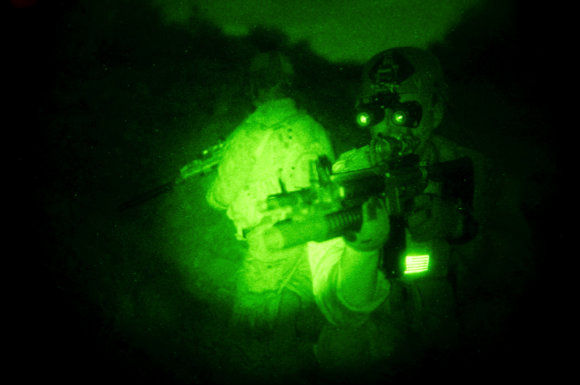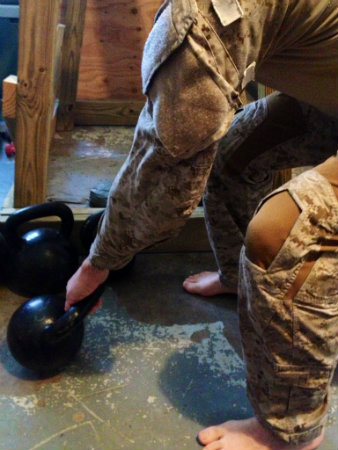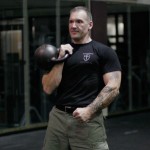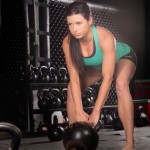I remember it very clearly. Somewhere in central Iraq, during my first “OP” in country, I stopped in my tracks. “What the hell?” I had read about this phenomenon many times but was not sure if I believed it. I did now.
Before finding kettlebells and the hardstyle methods, I trained like many others: cardio one day (running or swimming) and resistance training the other. On some days, I would do both. On paper, this program worked well, and I had results to prove it.
I always scored at the top of my age group on our physical readiness test (PRT). At the time, the SEAL PRT* was push-ups, pull-ups, sit-ups, a three-mile run and a long swim. I’m not exactly sure, but I believe the swim distance was a half mile. To score high for my age group, I needed to do 120 push-ups, 120 sit-ups, 25+ pull-ups, and take roughly 18 minutes on the run.
Yet, something was missing. When it came time to work, I just didn’t feel right. It felt like my body wasn’t working the way it was supposed to. I was in great shape by Navy standards, but when it came time to operate, I didn’t feel great. Spending hours and hours under load, as Gray Cook would say, wore me out. Moving under load (wearing body armor and or carrying a heavy ruck) was even worse. Shooting and moving, jumping, and climbing were difficult — and forget about down-man-drills (buddy carries). We were also always moving gear, guns, and ammo, and I always felt weak doing it.
Then in 2005, I saw something that would change my life. I didn’t know him well yet, but John Faas was in the corner of the gym with a funny looking implement (a kettlebell) doing an exercise I was certain would injure him (swings). He told me all about the kettlebell, his friend Pavel, and the website I could visit to learn more.
That night at home, I spent about five hours reading every article I could. Was it really possible to get in sufficient shape using this simple little tool and these basic movements? I decided to find out.
The What the Hell Effect in Action
A couple of weeks went by. My 16kg bell arrived along with a book. The delivery man commented, “What the hell?” as he dropped the package at my door step. That night I read and re-read the The Russian Kettlebell Challenge. The next day, I played around with my new 16kg bell.
Like so many, I thought I could train myself by using the book, the website, and a little coaching every now and then. My biggest mistake was not getting help from an instructor. That’s a topic for another day…
In short time, I was doing the movements well with the 16kg. I purchased the 24kg and started practicing with it. I had a deployment coming up and was interested to see how I’d do using this simple program: grinds one day, ballistics the next, recover the following day, then repeat.
Back to Iraq and my first operation in country. The OP was nothing to write home about. It actually went as planned, mostly. I’m not going to go into details, but at some point during the OP a light-bulb went off. “What the hell?” (Actually it was a Navy-approved version of the expression).
“How is this possible?” I thought. I moved better‘under load or otherwise. The load didn’t hurt me when I was standing still. I could carry things when called upon, jump over things, climb things, and just physically operate at a whole new level and all at a lower body weight — “What the hell?!”
I was a believer. To me, this was “strength with a greater purpose” before I’d even heard the expression. I couldn’t think of a better reason to be strong.
Fast Forward: Rite of Passage
Some time passed and I was deployed again. This time I went over with a new book, a new program, and a new goal. I’d be following Pavel’s “Rite of Passage” program (ROP). I had my trusty 24kg bell and a 32, just in case. All I did during that deployment was the ROP and of course a few walks under load.
Some time passed and I was able to do 5 ladders to 5 with my 24kg bell. For quite some time, all I needed was that trusty 24. Then, I started adding some practice with my 32, all at a body weight of 185lbs. On that deployment, I felt even stronger. The WTH effect was amplified. It was crazy to me how well I felt and moved. The really crazy part was yet to come…
Before summering in the desert, I devised a test and tested myself. The previous deployment had proven that the kettlebell could get me in better operational shape, but could it really improve my measurables? My test was simple: 5km run, bodyweight pull-ups, weighted pull-ups, bodyweight bench for reps, deadlift, and box jump for height. I would go on “vacation” (deployment) and do nothing other than the ROP. Then, I’d come home and see where I stood.
Just weeks after coming home, I retested. “WHAT THE ACTUAL HELL?” How was that possible? My 5km time was unchanged. Bodyweight pull-ups held steady around 25 reps (not bad). Weighted pull-ups were a different story. I could put two 24kg bells on my homemade dip belt and still crank out a good rep. No one believed me. I didn’t believe it myself!
This prompted me to try muscle-ups. This movement fascinated me. I’d never been able to do one. I could now do five. WTH!? My bodyweight bench went up by a couple of reps, even without touching a bench during that whole trip. I could jump on top of the highest box in the gym (nearly as high as my solar plexus).
But my deadlift progress impressed me the most. Before my trip, I could pull approximately two-times bodyweight. This wasn’t that bad, especially considering I have never been taught how to deadlift nor practiced it. When I retested, I was shocked. My new best deadlift was 2.5-times bodyweight. WHAT THE #$%!?
The What the Hell Effect Is for Real
The kettlebell got me in great shape, and better operational shape. It took less time, was more fun, and didn’t interfere with my ability to operate (with the exception of the SSST — don’t do that at night before an operation, just FYI). And I maintained — and even improved — some of the things I measured. I could not believe it. Later, I would go on to use the kettlebell to prepare myself for other adventures. I loved the simplicity and the max results with minimum effort aspect.
*At the time, the PRT was different from the PST of today. The PST is the physical screening test that candidates take in order to earn a chance to try out.
Have you also experienced this phenomenon? #WTHE







I had different experience, but also intersting. I had just gotten back from my LDS mission in 2010 and took a military fittness class in January 2011 not to unusual the normal routine of partner assited exercises, running in a variety of ways/circuit training etc. I hadn’t been able to touch my Kettlebells, a 35 pound and 50 pounder, for about 3 to 4 months and I didn’t know how to use them to well….long story short I went from sea level to about 4800 to 4850 feet above sea level and started doing swings and presses right away using a ladder system from beyond bodybuilding and did them with 2 minute rests, I had no idea about proper rest periods just observations from trial and error, swings were 30 to 50 total reps and same for clean and press. I started doing them on a Friday and we didn’t have an actual workout till Wed. or Fri. so a short period of time. We kept moving up and down stairs and running around and doing tons of timed period circuit training the usual 8 to 12 areas for about 1 minute each. I hadn’t run for a year and a half and keep in mind I had gone from sea level to higher elevation. The total workout was 45 to 50 minutes and although I wasn’t the fastest I didn’t have to stop to take a breather….not once. I kept doing the exercises and same story when we ran outside, major hills with inclines up and down, that kicked my butt and I did eventually have to walk, but I wasn’t in the best running shape to begin with and I’m convinced the only reason I did half as well on those outside runs, intially at least, was the kettlebells. The first time we did them I lasted 20 or 25 minutes at a gradual pace and I had to rest. Long story short I never got the greatest numbers, but the kettlebells were a big part in getting me through that class.
Great post Eric! Thanks for taking the time to share those experiences and can’t wait to read more.
Dear
I’m planning some KB goals & need help …
Can somebody point me to a SFG trainer in Belgium (Antwerp region), please?
Thank you
Great story and good results! I am a martial artist and looking for a simple way to work on my conditioning and strength. Would the rop a good choiche?
I don’t like to train with barbells and don’t have the room for them. I do have kettlebells and a pull up bar. But I still ditching for a good and simply routine to supplement my martial arts training.
Eric,
I was a decent track athlete in college, running mid to low 22s 200m dash and around 50 flat in the 400. Definitely faster than your average person. I was the same as you, great endurance, could do around 23 pull ups at my best, but completely fell apart under load. My body didn’t feel strong when I was loaded up! Eventually I had a 3rd degree hamstring tear running the 200, and I had to learn how to move all over again.
Enter the kettlebell. My physical therapist happened to be an RKC 1 (this was 2009) and he introduced this tool to me as a way to help rehab my hamstring and bullet proof it from further injury by helping it to toughen up under ballistic load. It also had the added effect of getting my glutes to engage in a way they had previously not.
To make a long story short, the kettlebell made me realize how truly weak my body was, and how poorly “integrated” it was when it was asked to perform tasks under load, especially loads that were asymmetrical (presses, single arm carries, TGUs, you name it.
It’s taken almost 5 years of consistent training, education, and focus on building a better base of quality movement to make me almost ready to pass the SFG standards. I’m signed up for the Seattle course in April. For a supposedly fast former college athlete, this tool has absolutely humbled me, and makes me wonder what could have been possible had I learned about it and integrated it in my training during my competition years, because I feel faster and more explosive now than ever before.
Great anecdote, Eric. Thank you.
Bret Hamilton
Fantastic anecdote, Eric!
I literally had the same thoughts when I first threw on a ruck: WTF? Except that I was angry… I was both barbell and PT test “strong” at the time, and yet, I felt like a sissy doing grunt work.
The physical resiliency and prowess built into the body through a diet of hardstyle ballistics and grinds is, truly, unbelievable: WTH?! I’ve seen this far too many times besides my own personal experience. For these reasons my programs and recommendations are thoroughly steeped in KB work.
Great to have you out front, Eric.
Al
Thanks for your service and thanks for Strongfirst!
Hoo-Yah!! Eric,
Had our Teams enjoyed the effects of Hard Style Kettlebell training back in my days…sigh.
Today’s volumous kit absolutely needs the “what the hell” benefits!
You share the very reason why most of us need SF Kettlebell training. Your testimony needs sharing, far and wide…beyond our community. I can envision kb contests at future UDT/SEAL Reunions!
Thanks!!
Operational Readiness = Top Functional Movement
Thanks, Eric! Love the real world application. Just finished Dan John’s 10,000 swing challenge. I am a believer!
Motivating and inspiring! Awesome! Been looking forward to some of the CEOs “adventures” while testing his kettlebell training. Can’t wait to hear some more.